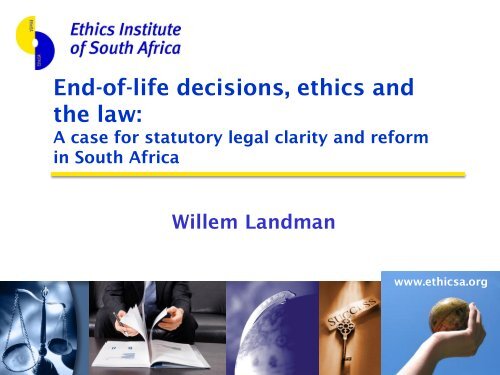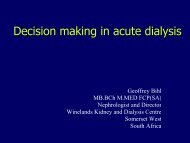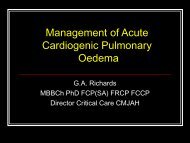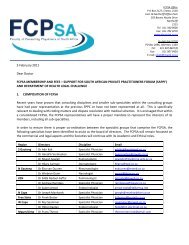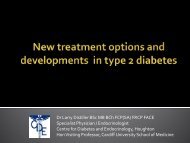End-of-life decisions, ethics and the law:
End-of-life decisions, ethics and the law:
End-of-life decisions, ethics and the law:
You also want an ePaper? Increase the reach of your titles
YUMPU automatically turns print PDFs into web optimized ePapers that Google loves.
Starting <strong>the</strong> public debate• Two sides <strong>of</strong> <strong>the</strong> pro-legalisation case– Argument (as in this Position Paper)– True stories (Sean Davison <strong>and</strong> o<strong>the</strong>rs)• Where to start– Revive <strong>the</strong> debate about <strong>the</strong> South AfricanLaw [Reform] Commission (“SALC”) Report<strong>and</strong> its draft bill – <strong>End</strong> <strong>of</strong> Life Decisions Act1998• Diginity SA petition• Petitioning Parliament3
Moral rights at stake1. Right to be free fromunnecessary suffering2. Right to a naturaldeath4. Right to assisted dying 3. Right to futurecontrol over one’sbody5
Ethical disagreements – Levels• Ethics <strong>of</strong>:– A practice – Is X ethical?• Is polygamy ethical?• Is termination <strong>of</strong> pregnancy (abortion) legal?• Is assisted dying ethical?– Decriminalising a practice – Should X belegalised?• Should polygamy be legal?• Should termination <strong>of</strong> pregnancy (abortion) be legal?• Should assisted dying be legal?7
Consensus on constitutional level• The Constitution should ground democraticconsensus– Consensus <strong>of</strong> citizens about spirit, values <strong>and</strong> rights <strong>of</strong>Constitution– The SALC Report (1998) <strong>and</strong> draft bill as point <strong>of</strong>departure for a national debate about legislation– Key constitutional (legal) issues• Interpretation– Right to <strong>life</strong> (limitations <strong>of</strong>)– Right to dignity (quality <strong>of</strong> <strong>life</strong> considerations)• Balancing– Individual interest in making autonomous end<strong>of</strong>-light<strong>decisions</strong>– Societal (state) interest in protecting <strong>life</strong>8
Perspectives on medical practices• Medical– What are <strong>the</strong> clinical facts?– What is st<strong>and</strong>ard-<strong>of</strong>-care medical practice?• Legal– What is <strong>the</strong> <strong>law</strong>?• Ethics– What should we do?• What is good, right <strong>and</strong> just?– What should <strong>the</strong> <strong>law</strong> be?9
1. Terminal pain management (1)• Terminology– Pain, distress, suffering– Comfort care, palliative care, symptom relief– Terminal illness, end-stage <strong>of</strong> terminal illness– Potentially <strong>life</strong>-shortening symptom relief– Palliative sedation, terminal sedation– Doctrine <strong>of</strong> double effect• Ethics– Moral right <strong>of</strong> individuals in <strong>the</strong> terminal phase <strong>of</strong>dying to be free from unnecessary suffering– Suffering <strong>and</strong> religion10
1. Terminal pain management (2)• Law– Under-treatment <strong>of</strong> pain– Treatment <strong>of</strong> pain legal, even if it potentiallyshortens <strong>life</strong>– Uncertainty about legal limits, if treatmentpotentially shortens <strong>life</strong>– Need legal clarification:• Recognition <strong>of</strong> doctrine <strong>of</strong> double effect• Immunisation <strong>of</strong> criminal <strong>and</strong> civil liability– SALC draft bill <strong>of</strong> 1998 introduces doctrine <strong>of</strong>double effect11
1. Terminal pain management (3)Question 9: Doctors fail to give adequate pain medication most <strong>of</strong>ten through fear <strong>of</strong> hastening a patient'sdeath.Neutral15%Stronglyagree + Agree54%Disagree31%Figure 9: Under-treatment <strong>of</strong> pain for fear <strong>of</strong> hastening death12
1. Terminal pain management (4)Question 10: Doctors fail to give adequate pain medication most <strong>of</strong>ten through fear <strong>of</strong> criminalprosecution for hastening a patient's death.Stronglyagree +Agree39%Neutral21%Disagree40%Figure 10: Under-treatment <strong>of</strong> pain for fear <strong>of</strong> criminal prosecution for hastening death13
2. Withholding <strong>and</strong> withdrawal <strong>of</strong>potentially <strong>life</strong>-sustaining treatment (1)• Terminology– Withholding, withdrawal – “Passive euthanasia”– Substitute/proxy/surrogate decision-maker– Unilateral refusal to treat• Ethics– Moral right to die a natural death <strong>of</strong> individuals in aterminal phase <strong>of</strong> dying– Futile treatment inappropriate(A) Competent persons• Autonomy, well-being, <strong>life</strong>, dignity• Autonomy – Individualism <strong>and</strong> community• Not merely biological <strong>life</strong>(B) Incompetent persons without advance directives• Clinically dead; PVS; rudimentary/no consciousness (Case Study 1)14
2. Withholding <strong>and</strong> withdrawal <strong>of</strong>potentially <strong>life</strong>-sustaining treatment (2)• Law(A) Competent persons•Section 7 <strong>of</strong> National Health Act 2003– Consent needed for all treatment, byimplication also for <strong>life</strong>-shortening treatment –Contemporaneous refusal• Legal clarification needed– Confirm that it covers potentially <strong>life</strong>shorteningrefusal <strong>of</strong> treatment– Withholding <strong>and</strong> withdrawal identical– Artificial nutrition <strong>and</strong> hydration– Mature, competent minors– SALC’s draft bill <strong>of</strong> 199815
2. Withholding <strong>and</strong> withdrawal <strong>of</strong>potentially <strong>life</strong>-sustaining treatment (3)• Law (continued)(B) Incompetent persons without advancedirectives– Substitute decision-making– Section 7 <strong>of</strong> <strong>the</strong> National Health Act 2003 makesprovision for• M<strong>and</strong>ating/appointing a substitute decision-making• Substitute decision-making without a m<strong>and</strong>ate– List <strong>of</strong> substitutes16
2. Withholding <strong>and</strong> withdrawal <strong>of</strong>potentially <strong>life</strong>-sustaining treatment (4)• Law (continued)– Legal clarification needed• Powers, formalities• Status <strong>of</strong> substitute• St<strong>and</strong>ard <strong>of</strong> care for medical practice versus futiletreatment• More than one substitute• Kinds <strong>of</strong> incompetence <strong>and</strong> clinical judgment(especially lack <strong>of</strong> higher brain function – See CaseStudy 1 on next slide)• Unilateral withholding/withdrawal <strong>of</strong> futile treatment• Depression• Severely defective newly born infants• SALC Reports draft bill <strong>of</strong> 199817
Withholding <strong>and</strong> withdrawing treatment – Case Study 1:Irreversibly non-responsive octogenarian patient in ICU• Mr X is an octogenarian male patient who is for allpractical purposes non-responsive to outside stimuli. Heonly shows occasional signs <strong>of</strong> rudimentary consciousness,his condition appears irreversible, <strong>and</strong> he shows no signs <strong>of</strong>improvement. He has been occupying a neurology intensivecare unit (ICU) bed for two years. He receives multiple dailymedications <strong>and</strong> is given physio<strong>the</strong>rapy daily, but his limbsremain rigid. He is treated aggressively with antibioticswhenever he contracts an infection. Three specialists visithim on an almost daily basis.• Mr X’s family wants everything done for him. His tophealthcare plan has paid all his medical bills, amounting toover R12 million.18
3. Advance directives (1)• Terminology– Advance directive• Ethics•Living will•Durable power <strong>of</strong> attorney for healthcare– Moral right <strong>of</strong> individuals to future controlover <strong>the</strong>ir bodies– Extension <strong>of</strong> contemporaneous decisionmaking(autonomy, well-being, dignity)19
3. Advance directives (2)• Law– Section 7 <strong>of</strong> <strong>the</strong> National Health Act 2003• Can indirectly infer living will• Allows for appointment <strong>of</strong> surrogate decision-maker– Advance directives need legal clarification• Recognise terminology• Iron out many practical questions about <strong>the</strong>irrequirements, status <strong>and</strong> operation– Treatment potentially hastening death?– Overriding a substitute?– Futile treatment sought by substitute?– More than one substitute – Clashes?– Immunity from criminal <strong>and</strong> civil liability?20
3. Advance directives (3)Question 12: Legalising advance directives (a living will <strong>and</strong> a health-care power <strong>of</strong> attorney) is a positivestep in clarifying a patient’s wishes regarding treatment at <strong>the</strong> end his or her <strong>life</strong>, or when incompetent.Strongly agree+ Agree75%Neutral13%Disagree12%Figure 12: The value <strong>of</strong> advance directives21
4. Assisted dying (1)• Terminology– Assisted dying – Wider <strong>and</strong> narrower– Assisted suicide– Euthanasia• Ethics• Root meaning• Passive <strong>and</strong> active (perspective <strong>of</strong> assister)• Voluntary, non-voluntary, involuntary (perspective <strong>of</strong> patient)– Moral right to assisted dying <strong>of</strong> individuals in <strong>the</strong> terminalphase <strong>of</strong> dying– Arguments for: (1) Personal autonomy; (2) Suffering; (3)Moral equivalence– Arguments against: (1) Playing God; (2) Pr<strong>of</strong>essionalresponsibilities: (3) Slippery slope22
4. Assisted dying (2)• Law– Assisted dying is un<strong>law</strong>ful– The <strong>ethics</strong> <strong>of</strong> legalising assisted dying– Ethical dilemma resolved by Constitution• Persons – Ethical disagreements about practices• Citizens - Ethical consensus aboutdecriminalising on basis <strong>of</strong> Constitution’s spirit,values <strong>and</strong> rights– Legal reform needed– Requires interpreting Constitution’s – The right to <strong>life</strong>• Intimately tied to <strong>the</strong> right to dignity• Balancing individual autonomy <strong>and</strong> society’s (state)interest in protecting human <strong>life</strong>– Common <strong>law</strong> <strong>and</strong> case <strong>law</strong>• Hartmann case 23
4. Assisted dying (3)• Law (continued)– Reopening <strong>the</strong> legislation debate• Judge Chaskalson – Limited relevance <strong>of</strong> public opinion• Soobramoney case– Three options in <strong>the</strong> SALC Report’s draft bill• Option 1: Remains un<strong>law</strong>ful• Option 2: Decriminalise – Doctor <strong>and</strong> patient decide• Option 3: Decriminalise – Committee decision24
4. Assisted dying (4)• Law (continued)– Outst<strong>and</strong>ing legal issues• Incremental approach?• Non-voluntary euthanasia• Terminal illness only?• Safeguards against abuse• Who may assist?• Mature, competent minors25
Assisted dying unnecessary?• Argument– We do not need to legalise assisted dyingbecause pain management <strong>and</strong> withholding<strong>and</strong> withdrawal <strong>of</strong> potentially <strong>life</strong>-sustainingtreatment are adequate instruments to carefor <strong>the</strong> dying. Moreover, Assisted dying wouldbe too risky to control <strong>and</strong> people would losetrust in <strong>the</strong> medical pr<strong>of</strong>ession.• Do you agree?– See Case Study 3 (next slide)26
Assisted dying – Case Study 3: Young woman dying<strong>of</strong> ovarian cancer (adapted from a real-<strong>life</strong> case )• A 20-year-old woman is dying <strong>of</strong> ovarian cancer. She is sufferingfrom unrelenting vomiting, apparently as <strong>the</strong> result <strong>of</strong> sedation.Her breathing is loud <strong>and</strong> laboured. She is emaciated, her eyesare hollow, <strong>and</strong> she appears much older than 20. She isreceiving nasal oxygen, has an IV, <strong>and</strong> is sitting in bed sufferingfrom what is obviously severe air hunger. She weighs 37kilograms, has suprasternal <strong>and</strong> intercostal retractions with herrapid inspirations, has not eaten or slept in two days, has notresponded to chemo<strong>the</strong>rapy, <strong>and</strong> is being given supportive careonly.• When her illness had initially turned for <strong>the</strong> worse, she discussedat length, with her attending physician <strong>and</strong> closest family, wha<strong>the</strong>r preferences would be should her disease progress to thispoint. Her mo<strong>the</strong>r sits with her, holding her h<strong>and</strong>. The youngwoman’s physician enters <strong>the</strong> room. Her only words are, “<strong>the</strong>time has come”. She looks at her mo<strong>the</strong>r, who nods.27
4. Assisted dying (6)Question 1: (Imagine assisted dying is <strong>law</strong>ful, with safeguards.) If a competent, terminally ill patient whois rational <strong>and</strong> reflective repeatedly asks you to inject drugs to end his or her <strong>life</strong>, are <strong>the</strong>re any situationswhere it would be acceptable for you to give a lethal injection?YES25%Uncertain15%Definitely not60%Figure 3: The <strong>ethics</strong> <strong>of</strong> doctor-assisted suicide28
4. Assisted dying (7)Question 2: (Imagine assisted dying is <strong>law</strong>ful, with safeguards.) If a competent, terminally ill patient whois rational <strong>and</strong> reflective repeatedly asks you to prescribe drugs so <strong>the</strong> patient can end his or her <strong>life</strong> byoverdose, are <strong>the</strong>re any situations where it would be acceptable for you to prescribe <strong>the</strong> drugs needed?YES27%Uncertain16%Definitely not57%Figure 4: The <strong>ethics</strong> <strong>of</strong> voluntary active euthanasia29
4. Assisted dying (8)Question 3: (Imagine assisted dying is <strong>law</strong>ful, with safeguards.) Can you imagine any future illness badenough that you might wish ei<strong>the</strong>r to self-prescribe medications to end your own <strong>life</strong> intentionally or tohave a colleague intentionally end it for you?YES43%Uncertain20%Definitely not37%Figure 5: Medical practitioners choosing assisted dying for <strong>the</strong>mselves30
4. Assisted dying (9)Question 4: In <strong>the</strong> course <strong>of</strong> your medical practice, has a patient ever asked you to hasten his or herdeath?No66%Yes34%Figure 6: Patients asking doctors to hasten <strong>the</strong>ir death31
4. Assisted dying (10)Question 7: The <strong>law</strong> should allow a doctor to provide drugs to a rational <strong>and</strong> reflective terminally illpatient who requests assistance with committing suicide.Neutral11%Stronglyagree + Agree38%Disagree51%Figure 7: Legalising doctor-assisted suicide32
4. Assisted dying (11)Question 8: The <strong>law</strong> should allow a doctor actively to end a patient’s <strong>life</strong> if a rational <strong>and</strong> reflectiveterminally ill patient asks <strong>the</strong> doctor to administer a lethal injection.Neutral13%Stronglyagree + Agree34%Disagree53%Figure 8: Legalising voluntary active euthanasia33
4. Assisted dying (12)Question 11: If a patient with intractable <strong>and</strong> unbearable pain <strong>and</strong> suffering, who is not terminally ill,asks me to end his or her <strong>life</strong>, I would do so if doctor-assisted dying were legal.Stronglyagree + Agree12%Neutral7%Disagree81%Figure 11: Terminal illness as a requirement for assisted dying34


